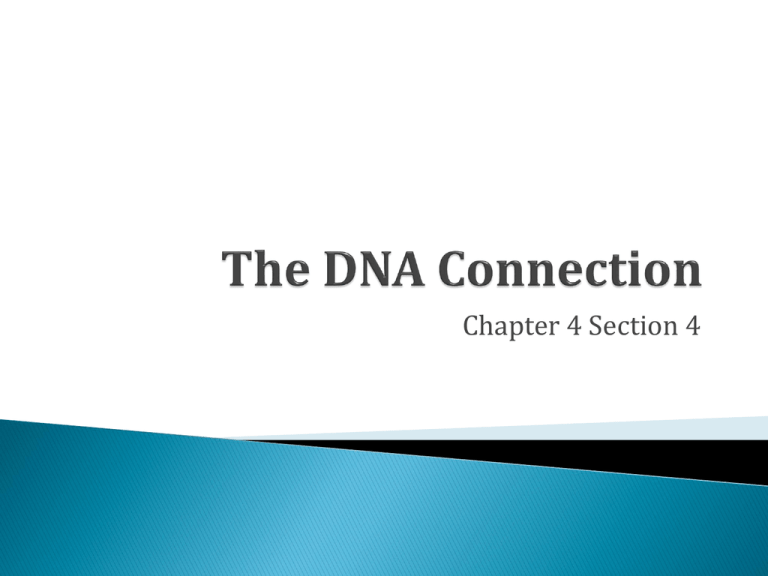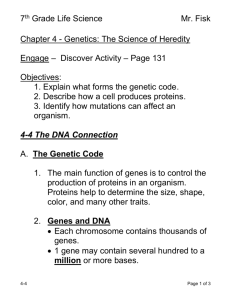Chapter 4 Section 4
advertisement

Chapter 4 Section 4 The main function of genes is to control the production of proteins in an organism’s cells Proteins help determine the size, shape, and many other traits of an organism Chromosome are composed mostly of DNA Review: DNA is made up of four different nitrogen bases… ◦ Adenine (A), Thymine (T), Guanine (G), Cytosine (C) A gene is a section of a DNA molecule that contains the information to code for one specific protein A gene is made up of a series of bases in a row The bases on a gene are arranged in a specific order The DNA Code The order of the nitrogen bases along a gene forms a genetic code that specifies what type of protein will be produced Proteins: long-chain molecules made of individual amino acids A group of three DNA bases codes for one specific amino acid Protein synthesis: production of proteins During protein synthesis, the cell uses information from a gene on a chromosome to produce a specific protein Where? Ribosomes in the cytoplasm Where are the chromosomes found? So how do they get into the cytoplasm… A “messenger” first carries the genetic code from the DNA inside the nucleus into the cytoplasm The genetic “messenger” is called ribonucleic acid, or RNA RNA and DNA differ in some important ways… ◦ RNA only has one strand ◦ Different sugar molecule ◦ RNA contains uracil instead of thymine Messenger RNA (mRNA): copies the coded message from the DNA in the nucleus, and carries the message from the ribosome in the cytoplasm. Transfer RNA (tRNA): carries amino acids to the ribosomes and adds them to the growing proteins Mutations: any change in a gene or chromosome ◦ Can cause a cell to produce an incorrect protein during protein synthesis ◦ The organisms trait, or phenotype may be different from what it normally would have been Body cell – the mutation will NOT be passed to offspring Sex cell – the mutation can be passed to an offspring and affect the offspring phenotype Substitution ◦ One base pair is substituted for another Deletion ◦ One base pair is removed Addition ◦ One base pair is added Mutations can be a source of genetic variety Some mutations can be helpful, some can be harmful Harmful to an organism if it reduces the organism’s chance for survival and reproduction A mutation that is harmful or helpful depends partly on the organism’s environment


